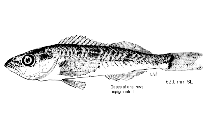| Most slender Sebastes species (body depth <25% SL); large larvae (5.4 mm SL at hatching, 8-10 mm SL at flexion); relatively shortest preanal distance in the genus (wide space between anus and anal fin); position of dorsal midline series and number of constituent melanophores; relatively short pectoral fins, usually lacking pigment; high pectoral fin ray count; relatively large size at hatching, flexion, and transformation stages; head spines inconspicuous after flexion stage.
Pigmentation:
Preflexion: initially, dorsolaterally on gut, patch over brain, 21-24 in postanal ventral series (from 3rd-5th to 14th-16th postanal myomere), 13-28 in dorsal midline series (from 7th-12th to 14th-16th postanal myomere); by end of stage, embedded above beginning to expand anteriad.
Postflexion: by 13.0 mm, on snout near upper jaw and beginning of patch on upper opercular region; by 15.0 mm, on lateral hypural region; by 20.0 mm, continuous on dorsum, beginning to form on epaxial region of body; on lower jaw; more on snout; on posterior hypural margin.
Transformation: entire epaxial region covered, heavier at dorsum and at myosepta.
Sequence of fin development: pectorals, caudal, dorsal and anal and pelvics.
Also Ref. 34817. |
